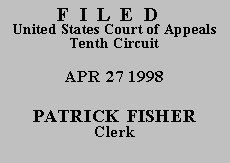

| LARRY ROBERSON,
Plaintiff-Appellant, v. KENNETH S. APFEL, Commissioner, Social Security Administration,(*) Defendant-Appellee. |
|
On appeal, claimant contends (1) the administrative law judge (ALJ) improperly evaluated his pain by failing to apply the correct standards to evaluate his credibility, (2) the ALJ failed to accord appropriate weight to the treating physicians' opinions, (3) the ALJ should have obtained an updated medical evaluation, and (4) the ALJ improperly based his determination on a lack of evidence, thereby keeping the burden of proof on claimant at step five, contrary to law.
We review the Commissioner's decision to determine whether it is supported by substantial evidence and whether correct legal standards were applied. See Hawkins v. Chater, 113 F.3d 1162, 1164 (10th Cir. 1997). "Substantial evidence is 'such relevant evidence as a reasonable mind might accept as adequate to support a conclusion.'" Soliz v. Chater, 82 F.3d 373, 375 (10th Cir. 1996) (quoting Richardson v. Perales, 402 U.S. 389, 401 (1971) (further quotation omitted)). We may neither reweigh the evidence nor substitute our judgment for that of the Commissioner. See Casias v. Secretary of Health & Human Servs., 933 F.2d 799, 800 (10th Cir. 1991).
The ALJ found that claimant's allegations of disabling pain were not fully credible. Claimant alleges that the ALJ disbelieved his pain allegations based solely on a lack of objective medical evidence to support them, and failed to link his credibility findings to the evidence. We disagree with that proposition. The ALJ was entitled to consider that claimant had not sought medical treatment since before May 1992. See Kepler v. Chater, 68 F.3d 387, 391 (10th Cir. 1995) (factors to be considered by ALJ in assessing credibility include extensiveness of attempts (medical or nonmedical) to obtain relief and frequency of medical contacts). The ALJ explained his reasons for discounting claimant's pain allegations, including the objective medical evidence, lack of medication for severe pain, infrequency of medical treatment, claimant's prior work record, his daily activities, and his demeanor at the hearing. Because we conclude that the ALJ properly linked his credibility findings to the record, see id., we find no reason to deviate from the general rule to accord deference to the ALJ's credibility determinations, see James v. Chater, 96 F.3d 1341, 1342 (10th Cir. 1996) (witness credibility is province of Commissioner whose judgment is entitled to considerable deference).
Claimant also argues that the ALJ failed to accord more weight to the opinions of claimant's treating physicians than to those of one of the consulting physicians, Dr. McGovern. Although the record contains evidence that claimant had sustained injuries to his back and shoulder, none of the physicians opined that his condition was permanently disabling. The opinions of the treating physicians did not conflict with Dr. McGovern's opinion. Therefore, the ALJ was not required to explain his reasons for rejecting a treating physician's opinion. See Miller v. Chater, 99 F.3d 972, 976 (10th Cir. 1996) (ALJ must give legitimate reasons to reject treating physician's opinion). Moreover, Dr. McGovern's May 1992 report was the only medical evidence submitted after November 1991, except for a brief reference to "a moderate amount of low back pain" on April 2, 1992, R. vol. II, at 156. In the absence of a treating physician's report for that time frame, the ALJ was not required to discount Dr. McGovern's report. See Reid v. Chater, 71 F.3d 372, 374 (10th Cir. 1995).
Claimant next asserts that the ALJ erred in failing to order a consultative medical examination for an update of his condition since the time of the first administrative hearing. "[T]he ALJ should order a consultative exam when evidence in the record establishes the reasonable possibility of the existence of a disability and the result of the consultative exam could reasonably be expected to be of material assistance in resolving the issue of disability." Hawkins, 113 F.3d at 1169. However, the record contains no evidence to suggest that another consultative examination would have produced material information. Claimant was represented at the administrative hearing by counsel on whom the ALJ was entitled to rely "to identify the issue or issues requiring further development," id. at 1167, but claimant's counsel did not identify any such issue at the hearing. Accordingly, the ALJ was not required to order another consultative examination.
Finally, we address claimant's contention that the ALJ failed to shift the burden of proof to the Commissioner at step five of the five-step evaluation process, see Williams v. Bowen, 844 F.2d 748, 750-52 (10th Cir. 1988) (discussing five steps, holding that burden at step five is on Commissioner). Claimant asserts that the ALJ determined claimant's residual functional capacity (RFC) before shifting the burden of proof. Because of this approach, he argues, the step-five burden remained on him. We disagree. In evaluating whether claimant could perform his past work the ALJ was required to ascertain his RFC. The ALJ correctly stated that the burden shifts if claimant shows he cannot perform his past work. The plain wording of the ALJ's decision makes it clear that he correctly placed the step-five burden on the Commissioner. Substantial evidence supports the Commissioner's determination that claimant is not disabled within the meaning of the Social Security Act.
AFFIRMED.
ENTERED FOR THE COURT
Circuit Judge
*. Pursuant to Fed. R. App. P. 43(c), Kenneth S. Apfel is substituted for John J. Callahan, former Acting Commissioner of Social Security, as the defendant in this action.
**. This order and judgment is not binding precedent, except under the doctrines of law of the case, res judicata, and collateral estoppel. The court generally disfavors the citation of orders and judgments; nevertheless, an order and judgment may be cited under the terms and conditions of 10th Cir. R. 36.3.
1. After examining the briefs and appellate record, this panel has determined unanimously to grant the parties' request for a decision on the briefs without oral argument. See Fed. R. App. P. 34(f); 10th Cir. R. 34.1.9. The case is therefore ordered submitted without oral argument.